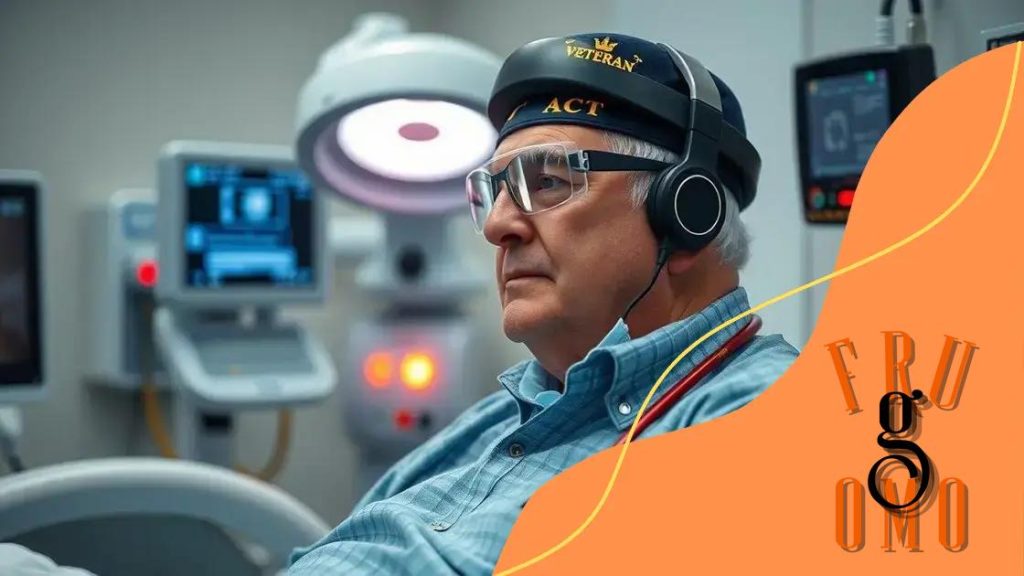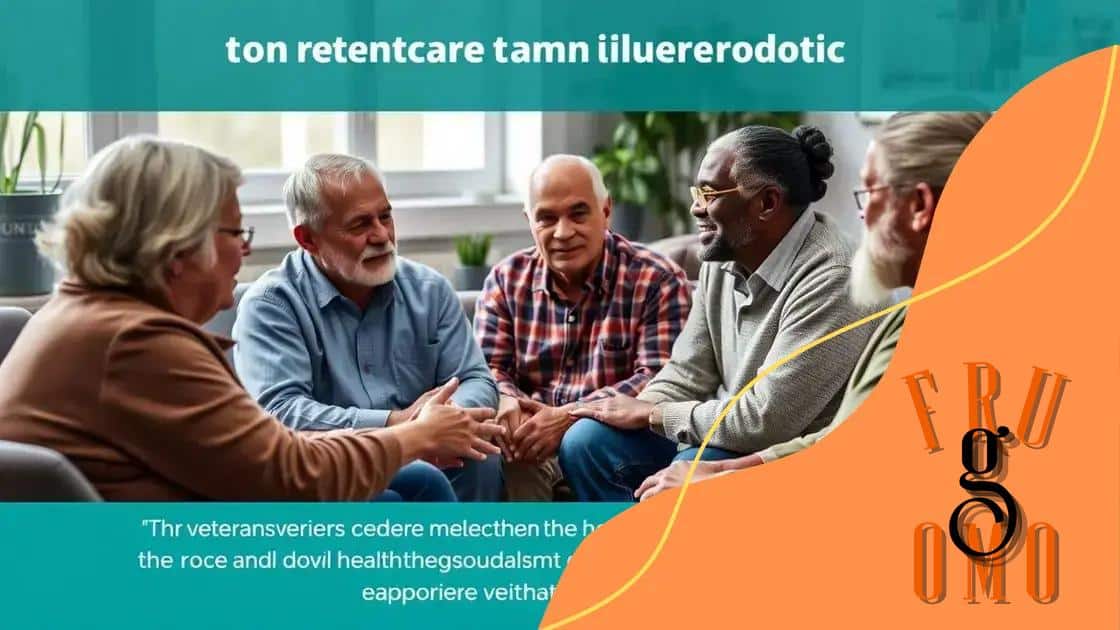Veterans’ healthcare modernization: transforming lives today

Veterans’ healthcare modernization focuses on integrating advanced technologies like telehealth and AI to enhance access, improve treatment personalization, and address current challenges in providing effective care for veterans.
Veterans’ healthcare modernization is reshaping the way our heroes receive medical care. With new technologies and approaches emerging, it’s crucial to understand how these changes impact their well-being. Are we doing enough to support their needs?
The current state of veterans’ healthcare
The current state of veterans’ healthcare reflects both progress and challenges. Many veterans are now receiving better access to essential services, but there is still much work to be done. This article explores the initiatives shaping this healthcare.
Improvements in Access
One of the notable improvements in veterans’ healthcare is the increased access to medical facilities. Programs like the Mission Act have expanded options for veterans to receive care, such as:
- Accessing local providers
- Shortening wait times for appointments
- Using telehealth services
These changes allow veterans to receive timely care without unnecessary delays. Moreover, many veterans now have more personalized health plans tailored to their specific needs.
Challenges and Gaps
Despite advancements, challenges remain prevalent in the system. The demand for services often outstrips supply, resulting in long wait times for specific treatments. Additionally, some veterans report difficulties in navigating the healthcare system, leading to inconsistent care.
Addressing these issues is crucial. Knowing who to contact can often make a difference in a veteran’s experience. For many, connecting with a case manager can provide guidance and aid in accessing necessary resources efficiently.
Moreover, mental health care continues to be an area needing improvement. Veterans face unique mental health challenges, including PTSD, that require specialized support. Expanding and enhancing mental health programs is vital to overall care.
In summary, the state of veterans’ healthcare is a mixture of progress and lingering challenges. While increased access and personalized care mark improvements, systemic issues and mental health needs highlight the path ahead.
Key technologies driving modernization
Key technologies are playing a vital role in the modernization of veterans’ healthcare. These advancements aim to enhance the quality of care while making it more accessible for veterans. With the right tools, healthcare can become more efficient and patient-centered.
Telehealth Services
Telehealth is one of the most significant innovations. By utilizing virtual appointments, veterans can connect with healthcare providers without needing to travel long distances. This is essential for those living in rural areas. Additionally, telehealth helps reduce wait times and provides greater flexibility in scheduling.
- Enhanced access to specialists
- Reduced travel costs and time
- Improved follow-up care
Such services not only remove barriers but also empower veterans to manage their health proactively.
Wearable Health Devices
Another technology revolutionizing veterans’ healthcare is the use of wearable health devices. These tools monitor vital signs, allowing vets to track their health in real-time. For instance, devices can monitor:
- Heart rate
- Blood pressure
- Activity levels
This immediate feedback enables veterans to take action quickly if any abnormalities arise. Moreover, providers can access data remotely, leading to more informed decisions and timely interventions.
Artificial intelligence (AI) is also making waves in healthcare. AI algorithms can analyze data to predict health trends and outcomes. For veterans, this might mean tailored treatment plans based on their unique health profiles. Additionally, chatbots offer 24/7 support, answering queries related to health benefits and available services.
In conclusion, these key technologies are paving the way for a more responsive and efficient veterans’ healthcare system. Embracing innovation is crucial for meeting the evolving needs of those who served our country.
Patient experiences and testimonials

Understanding patient experiences is crucial in evaluating the effectiveness of veterans’ healthcare modernization. Many veterans share their stories, highlighting both positive outcomes and areas needing improvement.
Positive Outcomes
Veterans have expressed gratitude for the advancements that provide them with easier access to care. For example, one veteran shared how telehealth allowed him to consult with a specialist without traveling hours. This convenience means veterans can receive timely care, ultimately improving their health outcomes.
- Reduced travel times lead to more frequent check-ups.
- Faster appointment scheduling enhances patient satisfaction.
- Telehealth support fosters a sense of connection with healthcare providers.
Additionally, many veterans report feeling more empowered in managing their health due to the availability of health data from wearable devices. This real-time monitoring enables them to take proactive steps regarding their well-being.
Challenges and Concerns
However, not all experiences are positive. Some veterans face difficulties navigating the new healthcare systems. For instance, one veteran mentioned the frustration of understanding different benefits available to him. The multitude of options can be overwhelming for those not used to digital tools.
Moreover, there are instances where veterans report long wait times for specific services or referrals, even with the modernization efforts. This inconsistency can lead to anxiety and uncertainty regarding their healthcare journeys. Veterans need clear communication and guidance to feel secure in their paths to healing.
Sharing these personal experiences can guide improvements in veterans’ healthcare, ensuring that services better align with their needs. Listening to veterans’ voices is essential for building a more effective healthcare system.
Challenges faced in implementation
Despite the progress in veterans’ healthcare modernization, several challenges arise during implementation. These hurdles affect the quality and accessibility of care that veterans receive.
System Integration Issues
One significant challenge is the integration of new technologies into existing healthcare systems. Many facilities still rely on outdated systems that complicate data sharing. For example, when a veteran visits multiple providers, they may encounter overlapping or missing information. This fragmentation can lead to inconsistencies in care and creates confusion for both patients and providers.
- Difficulty accessing comprehensive medical histories
- Delays in treatment due to inaccurate data
- Increased workload for healthcare staff
Addressing these integration issues is crucial for creating a seamless experience for veterans.
Training Healthcare Staff
Another challenge is adequately training healthcare staff to adapt to new technologies. Many veterans’ healthcare providers may be unfamiliar with modern systems, leading to inconsistent usage across facilities. Proper training programs must be developed to ensure staff can effectively use new tools and technologies. Lack of training can result in:
- Increased errors in patient care
- Lower confidence among healthcare providers
- Frustration for both staff and patients
Investing in comprehensive training can empower staff to provide better care to veterans.
Additionally, funding remains an ongoing challenge. While initiatives exist to improve veterans’ healthcare, securing sufficient funding to sustain modernization efforts can be difficult. Limited resources may hinder the ability to implement necessary upgrades or maintain quality services.
Focusing on resolving these challenges is essential for achieving the goals of veterans’ healthcare modernization. Effective solutions can enhance accessibility, quality, and overall satisfaction for veterans seeking care.
Future outlook for veterans’ healthcare
The future outlook for veterans’ healthcare is promising, with advancements on the horizon aimed at further enhancing the quality of care provided to veterans. As technology continues to evolve, the integration of new methods and practices is expected to address existing gaps and improve overall service delivery.
Emerging Technologies
One of the key components of future developments is the adoption of emerging technologies like artificial intelligence (AI) and machine learning. These tools can analyze vast amounts of data to predict health trends and personalize treatment plans for veterans. For instance, AI can help identify at-risk patients early, allowing for timely interventions.
- Predictive analytics for early detection of health issues
- Personalized treatment options based on individual health data
- Improved efficiency in administrative tasks and patient care
Such advancements could lead to significant improvements in health outcomes for veterans.
Telemedicine Expansion
Another exciting direction is the expansion of telemedicine services. With an increasing number of veterans utilizing remote consultations, this trend is likely to continue. It not only offers convenience but also reduces unnecessary travel, making healthcare more accessible. Veterans can consult with specialists from the comfort of their homes, which can be particularly beneficial for those with mobility challenges.
Moreover, virtual groups and support networks are becoming more common. This means veterans can connect with peers facing similar challenges, sharing experiences and support through digital platforms.
To support these advancements, policy changes may be required to ensure that veterans have access to the latest technologies and treatments. It’s essential to keep funding and resources aligned with the evolving needs of veterans.
Overall, the future of veterans’ healthcare looks bright. With continued innovation and a focus on patient-centered care, veterans can expect to receive the quality healthcare they deserve.
In conclusion, the modernization of veterans’ healthcare brings many exciting opportunities for improvement. With advancements in technology, veterans can access better care that meets their unique needs. Innovations like telehealth and wearable devices enhance the way veterans interact with their healthcare providers. While challenges remain, such as integration issues and training for staff, the future looks bright. By focusing on patient-centered solutions, we can ensure that veterans receive the quality care they deserve. Let’s continue to support these advancements for the health and well-being of our veterans.
FAQ – Frequently Asked Questions about Veterans’ Healthcare Modernization
What is telehealth and how does it benefit veterans?
Telehealth allows veterans to meet with healthcare providers remotely, making consultations easier and reducing the need for travel.
How are wearable devices used in veterans’ healthcare?
Wearable devices monitor health metrics in real-time, enabling veterans to keep track of vital signs and manage their health more effectively.
What challenges does the veterans’ healthcare system face?
The system struggles with integrating new technologies, training staff effectively, and ensuring adequate funding for modernization efforts.
What role does AI play in improving veterans’ healthcare?
AI helps analyze data to predict health trends and personalize treatment plans, making healthcare more effective and suited to each veteran’s needs.





